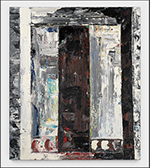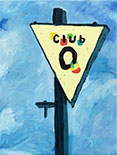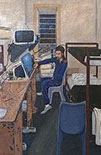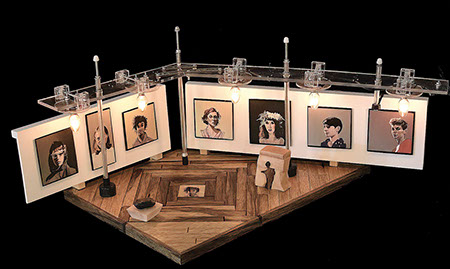






“Paintings, Miniatures, Wood Mosaics, and Imagery Boxes—Creative Emergence from the Pandemic”
SoNa Gallery, Chicago, August 11–October 14, 2023
by Annette LePique
This is a difficult review to write as Laura Botwinick, SoNa Gallery’s Executive Director and one of the new gallery’s two curators (the other, Molly O’Donnell) was nothing but kind, generous, and open with her time and space. Botwinick’s presence lent a sense of intimacy to the work of Chicago artists and long-time collaborators Tom Robinson and Lorylyn Kumlin.
But intimacy does not excuse poorly conceptualized art.
Robinson and Kumlin’s show, “Paintings, Miniatures, Wood Mosaics, and Imagery Boxes—Creative Emergence from the Pandemic” up at SoNa till mid-October, was borne of their shared turn to miniatures during the height of the pandemic. As Botwinick recalled, Robinson happened upon a gutted, but beautiful, Victorian dollhouse in an alley. He and Kumlin took on the project of refurbishing the dollhouse together, and they filled it with meticulously crafted miniature facsimiles of furniture, household decorations, and the everyday detritus of life. This shared project is intertwined in the show with the creation of Robinson’s miniature galleries and Kumlin’s “Imagery Boxes.”
While the show contains earlier work by each artist that trace the developments in their practices, their turn to the miniature form reveals an unbridgeable distance at the show’s heart. Robinson’s miniature scenes are duplications of gallery wings, his studio, and corridors of the Art Institute of Chicago. These likenesses are filled with approximations of his own paintings. His paintings, with their lush, dappled colors and tubercular models sit next to a tiny Edward Hopper and Manet reproduction in the Art Institute, and next to copies of Picassos in the halls of the dollhouse. Why does an artist reproduce their own work, hang it, light it, and christen it with the company of well-known pieces from the western art historical canon? It comes off as an unabashed song of the self, a paean to artistic ego. Robinson’s apparent turn to this self-obsessed, inward gaze is disappointing, as it has borne art that aspires to live in the realm of the rich. Nothing is said, nothing is done, nothing is changed, it’s simply an endorsement of the status quo.
This is a show that unknowingly reveals the deep alienation that girds each artist’s forays into market-oriented narcissism. But it is Kumlin’s recent work that betrays something deeply upsetting about the neoliberal relationship to history, society, and identity. As the artist dabbles in virtue signaling and we see her memorialization of her participation in the 2017 Women’s March in her 2023 Crash Box, she should also feel compelled to address the following questions in her work: what do the real-life subjects of your imagery boxes mean to you? Who are Rosa Parks, Katherine Johnson, and the four young victims of the terrorist attack on Birmingham, Alabama’s Sixteenth Street Baptist Church to you?
What is your relationship to these real, flesh and blood people, who lived, struggled, and survived? Why is their history yours to tell? Why was the original title of the piece 4 Lil Girls (only recently changed to Birmingham Girls)? Why did you take the liberty of using the colloquial “lil” in lieu of “little”? Why have you entombed these girls in a makeshift funeral parlor, instead of one of their far too brief moments of play?
%20rgb.jpg?crc=3974964075)
%20rgb.jpg?crc=215921482)
%20rgb.jpg?crc=314452814)
%20rgb.jpg?crc=4265796390)
Loralyn Kumlin, Birmingham Girls, 2022. Imagery Box Left to right: Addie Mae Collins (age 14), Carole Robertson (age 14),
Denise McNair (age 11), and Cynthia Wesley (age 14). Mixed media, H 11” x W 19-1/2” x D 10-7/8.” Photos: SoNa Gallery.
It’s a pity that both artists have taken such misguided turns, especially when both Kumlin’s and Robinson’s newer pieces are compared to Robinson’s past work. His past forays into woodworking are notable as they hint at a buried craftsman and possess a level of careful attention that is not found anywhere else in the show. Robinson’s “DeLawn” wood mosaic, part of his Twins series features the face of a young Black model, haloed by dreadlocks, and formed through alternating hues of wenge and ebony wood. The piece is itself a diptych, with the young model’s face replicated in mirror image. The two mosaics are immense and dominate the gallery’s back wall. The piece’s size, in combination with its painstaking detail gives the show a much-needed sense of grandeur, a perspective other than the somewhat suffocating presence of both artists’ self-fixation.

Tom Robinson, “DeLawn” Twins Series, 2010. Wood Mosaic, natural wood (no stains), predominantly wenge and ebony,
H 35" x W 68-1/2" x D 2" (each section of the diptych is 31-1/4" wide, with 6 inches between them). Photo: SoNa Gallery.
Perhaps this is the best note to close on: the search for something other than misplaced moral positioning or self-congratulatory fixation is long and arduous, but it can sometimes lead to the discovery of something interesting.
Annette LePique is an arts writer. Her interests include the moving image and psychoanalysis. She has written for Newcity, ArtReview, Chicago Reader, Stillpoint Magazine, Spectator Film Journal, and others.

Tom Robinson, Gallery 6 #2, 2022. Mixed Media, H 13" x W 33" x D 18-3/4.”
Photo: SoNa Gallery.